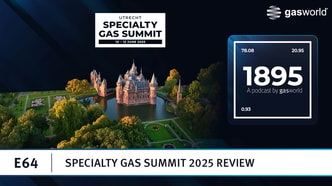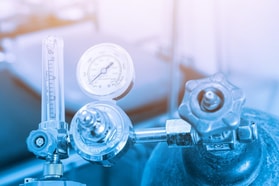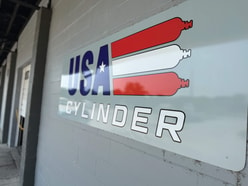Part 4: The wonderful world of composites
Historical Background
Composite materials are used to form high strength, low weight components. Naturally occurring composite materials which utilise these attributes are all around us in the form of wood, bones, teeth etc. In the nineteenth century, Napoleon utilised the principle to strengthen the barrels of his cannons by wrapping high strength steel wire around them.
Nowadays, composite materials are used for a huge range of industrial components in aerospace, road vehicles, through to sporting applications such as pole vaults and golf clubs. Somewhere in between these applications, lie composite gas cylinders (composites for short), which utilise both the low density/high strength properties of composite materials.
In fact, the earliest composite cylinders were not too dissimilar from Napoleon’s gun barrels. In the mid-twentieth century, again for a military application, seamless steel cylinders were carefully wrapped with steel wire, which were retained in-situ with a thin layer of a tin-alloy. Then in the 1960’s, the U.S government supported research within NASA to develop fuel vessels and rocket casings wrapped along their parallel length with a fibre-reinforced plastic (FRP). The spin-off from the latter was a hoop-wrapped cylinder with an aluminium liner during the late 1970’s.
Composite combinations
on the market
From these early beginnings, the last 30 years have thrown up a huge barrage of composite cylinder concepts. For routine high pressure applications the liner materials onto which the FRP is wrapped have been metallic materials all with varying strength levels such as, low alloy steels, stainless steels and aluminium alloys, different types of polymers, and while for low pressure gases e.g. liquefied petroleum gas, a linerless configuration is also a used configuration (Type 4). The associated fibres have a similar widespread chemistry from glass fibres in the early days, to the more advanced carbon and man-made Aramides in recent years.
Not only are hoop-wrapped (H-W) composites manufactured (Type 2), see Fig. 1, but so also are fully-wrapped (F-W) ones (Type 3), see Fig. 2, where apart from the parallel wall of the cylinder, the two ends are also wrapped. The F-W technique allows a whole array of liners to be wrapped from conventional cylinders, to spheres, through to shapes which need to be accommodated in specific available cavities. Such is the power of composite cylinder technology!
The exact combination of fibre/matrix (or no matrix) is a very delicate balance between the required cylinder efficiency and the price the customer is prepared to pay for the pressure vessel. Whereas a conventional 50 litre, 200 bar working pressure, seamless chromium-molybdenum steel (Type 1) cylinder has a technical efficiency of around 0.18m3 oxygen/kg of steel, and though it is difficult to be precise due to the many potential combinations which composite cylinders have, a comparable hoop-wrapped cylinder boasts its efficiency at around 0.40m3 O2/kg.
Design versus safety
Composite cylinders are as much in contact with the public, if not more so, as conventional all-metal cylinders. Hence regulations and standards which govern the manufacture and use of composites need to be comparable and provide an $quot;equivalent$quot; level of safety as their all-metal counterparts.The word $quot;equivalent$quot; is used since whereas all-metal cylinders are designed using well established stress equations, such as the Lame-von Mises formula, based on reliable strength of material properties, the huge complexity of stresses within a composite cylinder, makes such traditional calculations almost impossible to execute. Thus composite cylinders are made to follow a detailed series of stringent and pragmatic tests, which attempt to simulate the rigours of service conditions. Some tests are still being introduced into the standards, due to the newness of this breed of cylinders onto the market, whilst the stringency of tests already specified not only tests classic features that are tested for the all-metal cylinder, but also includes for a cylinder to survive without any leaks, after having been kept at it’s test pressure (which is 50% higher than it’s working/service pressure) for 2000 hours at 70oC in a humid atmosphere.
Even such harsh testing, often well beyond normal service conditions, is not sufficient for some regulatory authorities, who, being conservative in nature, due to the possible effects of accidents with gas cylinders, demand that a design assessment is also performed by the manufacturer. The latter usually takes the form of a finite element analysis. Thus it can be seen that getting approval to make composites is a very time consuming and expensive exercise.
Additional features which have provided greater assurance for manufacturers, the authorities and users, are that the minimum guaranteed burst pressure/test pressure ratio for composites is higher than that for all-metal cylinders, e.g. for a 300 bar test pressure, hoop-wrapped cylinder the calculated burst pressure is 501 bar, whereas the all-metal counterpart requires only 480 bar and that most types of composites are limited in their total life in service.
Applications for composite cylinders
Due to its light weight, the attractions are varied. They range from recreational uses such as SCUBA (for diving) to mountaineering, to medical and fire-fighting applications for storing breathing gases such as oxygen and Entonox, through to industrial applications for containing fuels such as CNG and hydrogen for on-board vehicles, propane for domestic applications and more recently welding applications.
The manufacturing route
Manufacturing composite cylinders is a closely guarded secret. However the principle behind the hoop-wrapped version are well known and typically consists of the liner material being carefully wrapped with the fibres, the latter having been previously impregnated with a mixed epoxy resin, by passing them through a bath kept at around 40-45oC.
Excess resin is removed and the tensioned fibres woven onto the liner, having had their pitch and the number of turns to be applied, previously calculated, for the cylinder’s desired working pressure. The whole assembly is finally cured to harden the resin.
It is during the next phase of production, called AUTOFRETTAGE, where the real composite cylinder is born. Here the liner/fibre-wrapped assembly is hydraulically pressurised to around 15-20% above its test pressure, such that the liner material is stretched to beyond its yield point and into the liner material’s plastic zone. Thus the liner experiences a permanent deformation. This critical process ensures that the fibre composite and the liner are both mechanically combined and the whole assembly functions as a single unit in subsequent pressurisation cycles, during the cylinder’s future life. When the pressure is removed the liner is under a compressive mode.
... to continue reading you must be subscribed









